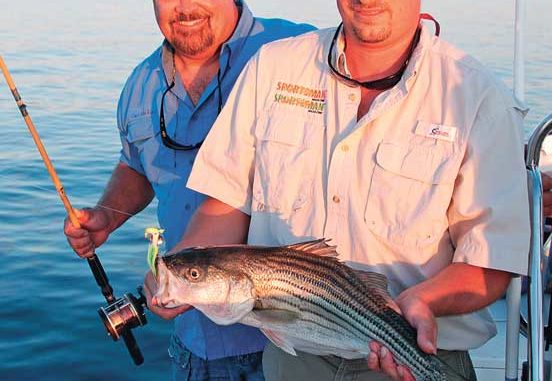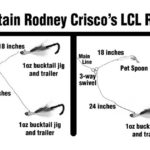
Trolling tactics will increase your summer striper success.
The hum of the big 4-stroke was a far cry from the outboards of yesterday — the days when trolling open water meant yelling at your buddy if he happened to be standing on the opposite side of the outboard.
Two anglers stood side-by-side, simultaneously monitoring the brightly-colored graph in front of them and the hardware attached to the boat’s transom behind. Tracking along the edge of the Catawba River channel in Lake Norman the boat’s graph clouded up with “activity.” Capt. Rodney Crisco deemed the signals to be a school of white perch nagging incessantly at a pod of baitfish. But among the marks were heavier blips, stripers, Crisco concluded.
As if on cue, one of the dull yellow transom rods bowed over, and brightly-colored line spun from its reel. Crisco stepped in, picked up the rod and began maneuvering the fish to the surface.
Across North Carolina’s Piedmont lakes, August temperatures soar to their highest levels of the year. The surface waters bake in the summer sun, and temperatures reach well into the upper 80s. Along with the summer sun comes a separation of water layers beneath the surface. Cold water sinks to the bottom, where the oxygen disappears, and warm water rises, too hot to sustain the metabolism of striped bass, which thrive in cooler waters.
What’s left is a thin band of suitable water where the thermally-stressed fish hold out — waiting for the change of seasons.
“In August, the stripers in our lakes are scattered,” said Crisco, a guide from Albemarle who has been striper-fishing for 20 years. “They don’t bunch up like they do in the spring, and they’re under a lot more stress due to the high water temperatures. Because they are so attuned to specific depths that hold suitable water for them, getting your baits down to those depths is a must to catch fish.”
Determining the depth of presentation is accomplished two ways: trolling with leadcore line and/or using downriggers. Crisco admits favoring leadcore line, which is fortunate, because his long-time partner Mike Lundy is an expert with downriggers.
Leadcore line is exactly what it sounds like: a continuous strip of lead sheathed in nylon braid. The appeal of leadcore is that it sinks better than standard line, getting to the depths where stripers are holding. Crisco said that standard leadcore tests are 18-, 27- and 36-pound test, with 27 being the hands-down favorite among veteran striper fishermen.
Leadcore is multi-colored, with colors changing every 10 feet. The variation is used to discern the amount of line out — by counting colors. Crisco uses the color coordination as a formula for depth control.
“Although all boats are a little different, at a trolling speed of 2 to 2½ miles per hour, a bait on leadcore will sink 3½ to 4 feet per color,” Crisco said. “By watching your graph and marking fish, you can let out the numbers of colors to get down to them.”
At the tag end of the line, Crisco attaches a 50-foot section of 20-pound mono or fluorocarbon leader with a double uni-knot. To the other end of the leader, Crisco ties a 3-way swivel with either a double-bucktail rig, a bucktail and spoon or a combination that includes hard stick baits.
“Trolling with leadcore lets you cover a lot of water, which is essential since fish may be in a number of different places, and it creates strikes,” Crisco said. “Most of these are reaction strikes rather than feeding bites. I believe a lot of stripers follow white perch schools around and let them do all the work of injuring baitfish, because they don’t want to expend the energy. Then, right out of the blue, here comes this rig with all this action, noise, and color barreling right down on them, and they hit it on impulse.”
Crisco’s heavy-metal, leadcore tactics are not the only deepwater presentations available. The king of the lead ball is Lundy, who gained much of his experience with downriggers while chasing king mackerel in the fall.
“In hot weather, we can troll about as fast as the bait will let us,” Lundy said. “If you’re trolling through fish at 2 miles per hour and aren’t getting bites, trying bumping it up to 3 or 3½ mph. It’s important to know what speed your boat will troll. Some boats have trouble getting down to 2 or 3 mph, and you might have to drag a 5-gallon bucket or drift sock to maintain a slow speed.”
Lundy runs his downrigger balls in nearly the same locations as Crisco’s leadcore. He may stay a little closer to the channel so he doesn’t top out on a long point, and he stays glued to the depthfinder to watch out both for fish andstructure that might rise from the bottom and hang his downrigger balls.
“I either replace the steel downrigger cable that comes on most models or string 150-pound braided Dacron line over the top of the spool,” Lundy said. “That eliminates the humming noise you get from the steel. I think that high-pitched noise can spook fish.”
Another secret of Lundy’s is to use a rubber band on the line to attach to the downrigger release. Lundy uses two lines per ball, employing a stacker release about midway up the line. He believes the rubber band gives the baits a smoother pull and will release easier on a small fish — a big problem as they will often spin on the line, grab other lines and weave them into a mess.
“I like to run a spoon or a bucktail on the upper line … about 10 feet back from the cable” said Lundy. “Then, I’ll attach a single stickbait to the bottom release and run it back anywhere from 20 to 30 feet.”
Lundy likes any kind of suspending hard bait with a small lip. His favorites are Smithwick Rattling Rogues, Redfins or Bombers. He prefers suspending baits that will dive four to five when trolled. Since the bottom release is four to five feet above the ball, he knows exactly how deep that bottom bait is working, and that’s the one he puts dead on the fish he sees on the sonar.
Both Crisco and Lundy point to Lake Norman as a prime example of a heavy-metal striper lake. Norman’s two power plants and below-average flow rates create a substantial thermal squeeze, concentrating stripers into minimal space. Because of this, big stripers don’t survive well in the reservoir, which has a reputation more for numbers of fish than sizes.
“There are several major creeks intersections in the lower lake area, and the mouths of those creeks and intersections with the main channel are where you’ll often find stripers,” said Crisco. “Davidson Creek and Mountain Creek down the lake are two of the most popular. Start at the mouths and work back for about the first third of the creek.”
While both creeks see a lot of action, Crisco prefers main-lake points and humps on Norman.
“Find a good leadcore spot on the main lake, and you’re almost sure to be working around one of the red or green markers used for navigation on the lake,” he said.
Crisco says the process used to cool the hydroelectric plant at mid-lake — the Marshall Steam Station — artificially heats the water, and that adds to the stress stripers feel in the summer. “The upside is that over the last couple of years, the lake’s growing blueback herring population has really improved the down-lake bite during the summer,” he said.
The Blythe Landing near Huntersville is Crisco’s preferred access area.
Deep summer trolling on Jordan Lake near Pittsboro is more of a mid-lake event, in part because Jordan has a smaller basin in the upper lake. Crisco puts in at the Ebenezer Ramp on SR 1008 just south of Wilsonville, and he trolls from just outside the ramp area up to the Rt. 64 bridge. From there, he’ll turn and go back down lake to the area known as the “S” turns.
“Jordan doesn’t have as well-defined a channel as some North Carolina lakes, but what it does have is a submerged railroad that runs just off the right bank in 20 to 25 feet of water” he said. “That railroad grade attracts a lot of fish, and it’s a great place to troll alongside.”
Lundy points to several creek intersections in the main-lake Jordan basin, preferring Parkers Creek, the Haw River, and Beaver Creek when trolling downriggers.
Badin is truly Crisco’s home lake, a place he knows and describes as a big-fish magnet, based on the last few seasons. His favorite trolling spots are major points off the main channel, as well as humps adjacent to deep water.
“The Palmer Mountain area, Graveyard Island, and the mouth of Machine Branch are all good spots to both troll leadcore and run downriggers,” Crisco said. “There’s not that many major creek intersections, so we’re usually out in the main lake in front of the lower dam. In fact, the two points off the run that goes back to the dam are really good places to troll.”
One of Lundy’s favorite spots on Badin is the Gladys Fork area, which dumps into the main lake several miles east of the dam, near the mouth of Reynolds Creek.
“The chain of islands on that arm of Badin will hold striped bass year-round. Those areas are adjacent to deep water as well. Look for scattered schools of bait and its likely stripers will be somewhere close by,” said Lundy, who likes the public access area off Rt. 740 across from the Alcoa plant, or at Fish Tales Marina in Reynolds Creek.













Be the first to comment